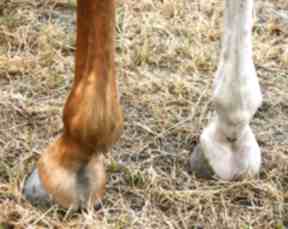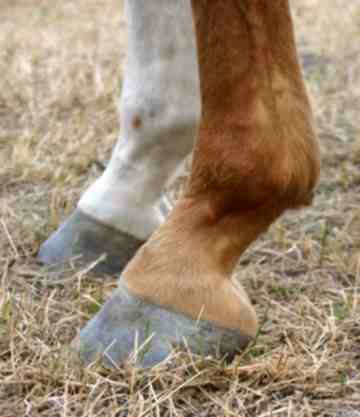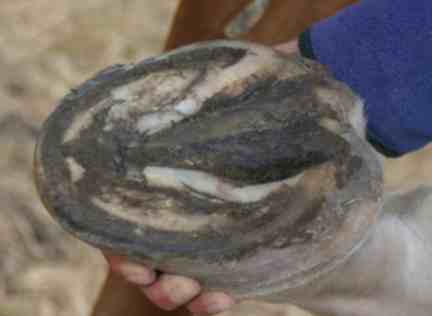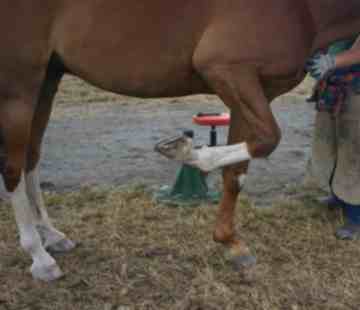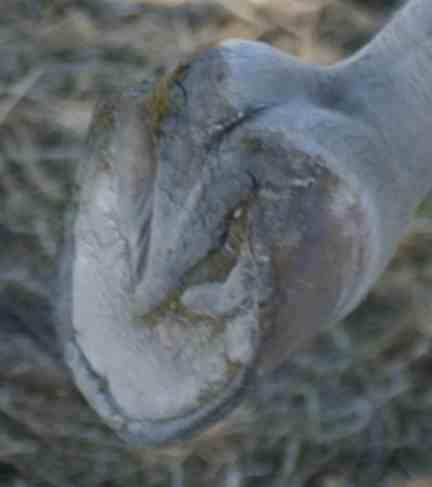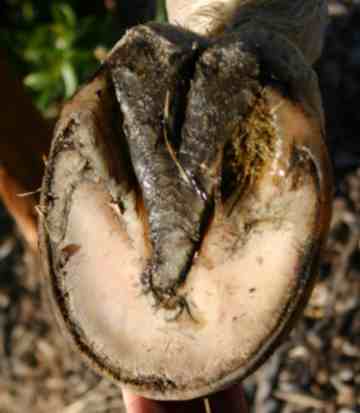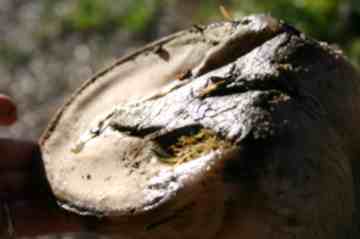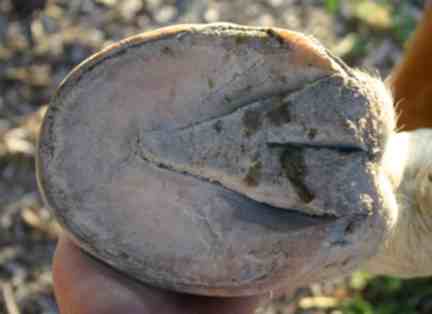 |
HealthyHoof.comHoofcare & Information for Barefoot SoundnessLinda Cowles Hoof Care - Serving the greater SF Bay Area and Northern California |
Piper6/2005
|
|||
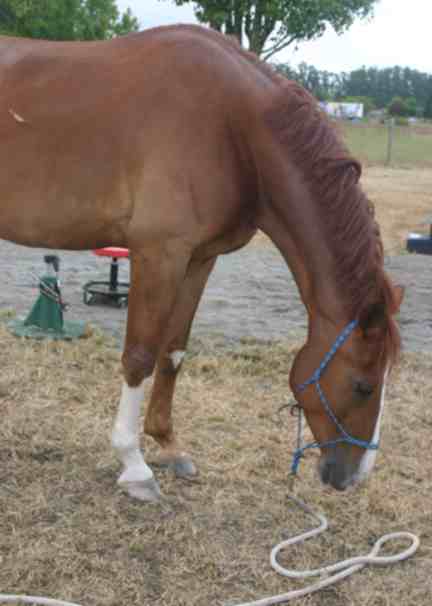 Above: Piper
before his trim. Note the high
heels and long toe. Also, the
coronet flares up in the quarters,
than back down again in the
heel region.
Above: Before the trim. From the rear, his heels are very contracted.
Above: as I trimmed Pipers front right foot, I noticed that the bar had completely surrounded the frog. I didn't pull out the camera until I'd removed much of the bar. The frog had been trimmed by his prior farrier |
6/2005 Piper is a recently imported Dutch Warmblood trained to second level. His owner Lauri describes him as very willing and responsive, but slightly short strided. He's a perfect gentleman about everything except his feet. He had been good about having his shoes pulled, but was very resistant to having his feet worked with since. Lauri reported that he had been lifting his front right leg up intermittently, as if it ached. He didn't do this when he was shod. I had the feeling that his front feet stung or tingled... it reminded me of having sensation restored to a leg that I'd sat on, folded under me, for too long. Piper had been completely vet checked as sound prior to importing. Attitude Piper has a very kind eye that gets a worried look as I reach for his foot. He was extremely resistant to having his feet worked on, and he repeatedly lunged into me during the setup trim. He was very worried about his feet. Piper was very hard to handle, and his feet looked extremely constipated and tight, so we decided to work with him on a weekly basis until he had 4 good feet to stand on. The first day, I rolled the walls on all four feet as best I could, then focused on the front right hoof. Piper was sound when shod and remained sound when the shoes were removed, but was a bit tender on rocks, which we expected. While he was sound, his owner and her trainer detected subtle imbalance and stiffness when he moved. Removing his shoes didn't change this, nor did trimming.. The Initial TrimThe first thing I noticed when I looked at his soles was that his bars completely surrounded the frog and covered the heel buttress on all four feet. The front right was seemed to be bothering him. I trimmed the bar from around the frog, getting it to the level of the sole. After finishing his front right, I decided to handle the front left differently. I decided not to remove the bar from the left foot; he was a real handful to manage, and I hate to tranquilize horses for trimming. Instead, I set the hoof up to shed the bar better. I rolled the wall, took the heel down and pulled the heel buttress back to a balanced position. I had been able to get more heel off the front right foot that the left, but it was a concession to Pipers reluctance to be trimmed. I then removed excess quarter wall length, shortening the wall in the quarter to the level of the sole with a rasp. This gave it the appearance of a conservative mustang type scoop, but would disappear quickly. .Relieving the wall pressure this way allows the quarter wall to drop into balance and encourages the hoof to release the retained bar. This hoof is in transition and a mustang-like quarter wall scoop scoop is a characteristic of a very fit hoof. I wasn't able to get the bar on the right front where I wanted it and hadn't touched the bar on the left front at all, but I had both front feet shaped (working from the top of the hoof) to help them shed bar better. Piper was was sound and willing under saddle in shoes and out, but was short-strided. He has a nice shoulder and potentially has great scope... I think he'll turn out to be a great mover!
Above: Piper's
"stinging feet" stance.
He did this repeatedly during
the first trim, and Lauri reports
that he'd done it in pasture
after having his shoes removed,
and that he did it less often
after being trimmed. We later
discussed this with vet Dr.
Kerry Ridgway, who felt it was
very likely a stress related
habit, like lip flapping. |
||
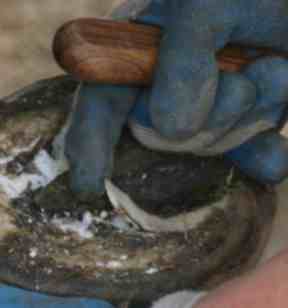 |
Left: The bar came up easily in chunks; all I had to do was pry it a bit with my knife. Right: These feet seemed
to be sensitive because of
the bar, so I trimmed bar
on the front right, the hoof
that appeared to bother him
the most, even though he was
resisting it.
|
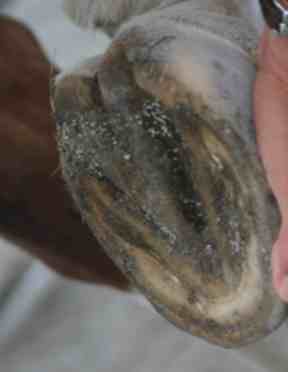 |
|
|
Second Trim, 6/28/05 Wall and frog seem to grow dramatically in relation to the sole after a setup trim; they are growing - I can see it in the coronet band - but perhaps not as dramatically as it might appear from the sole and this is a good example of that happening. I had trimmed the wall on the foot to the left just slightly longer than the sole, and it has already "grown" enough to start flaring very slightly. What happens is complex, but part of the transformation to a robust hoof occurs when the exposed sole, wall and bar fibers get "mashed" into a smooth, dense material - callous - as the horse uses a newly trimmed hoof. The hoof wall is growing, but it appears that the sole condenses into callous more than the wall edge. After just 10 days, his heel bulbs and quarters have relaxed; I wish I'd measured so that we could track how fast his feet are de contracting!! When I picked up the left front foot (below) I was thrilled to see that the bar was loosening naturally and would be easy to remove with bonsai trimmers While this heel looks **much** more relaxed than before, it isn't as relaxed as the right front (see at the left) , which I'd trimmed the bar from. I rolled his toes a bit more after removing the bar. The owner has encouraged me to do less more often, and will use soaking boots to help move these feet along. |
||
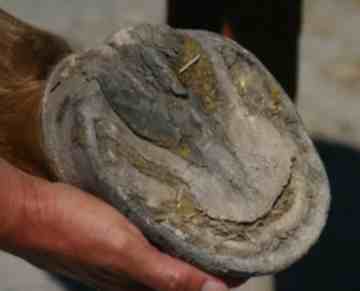 |
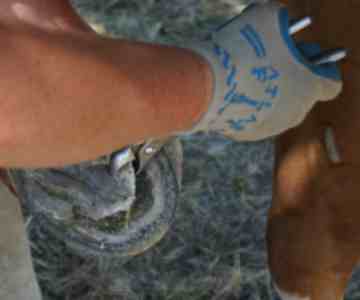 |
||
Third Trim, 7/13/2005 I brought my rotary tool to clean up Pipers bars. My plan was"
Attitude Change... Pipers attitude towards trimming has improved dramatically over the past three weeks. Initially he lunged into my lap to avoid having his feet worked on, and for this trim he stood quietly with the lead over his back as I used the Dremil to fine tune his bars... a great transformation! I still wasn't able to work on his rear feet, and didn't know why. He was still slightly off and I suspected that he had something going on that made lifting his legs painful. There is still some "run-amuck" bar covering the sole in the heel buttress area, and I want to smooth. His feet are developing nicely, but don't have a lot of callous yet. He lives in a field that has lots of 3 to 6 inch rock in the soil, he has access to sand and walks on that occasionally. His owner rides him several times a week in a course sand arena. His owner and I soak his feet to help them remodel. Piper is in an almost ideal situation for rehabbing this type of foot. |
|||
Below: Pipers foot after soaking before the 3rd trim. Notice the fine layer of bar still covering the heel buttress. I haven't trimmed any sole on this horse; I only trimmed the bar that filled the sulcus The heels have spread nicely in the past three weeks; I believe they will spread faster now that we're starting to soak his feet. . |
|||
| Below: Pipers foot after soaking and lunging in sand (before the 3rd trim). Notice the fine layer of bar still covering the heel buttress on the left has loosened and has started to pop off the sole; this was a result of the combination of soaking and lunging. | |||
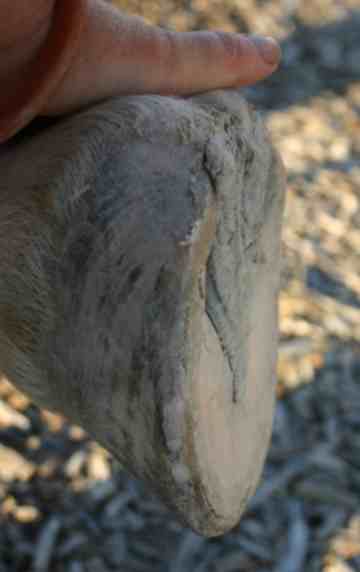 |
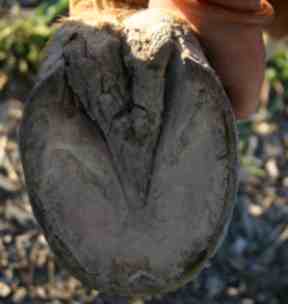 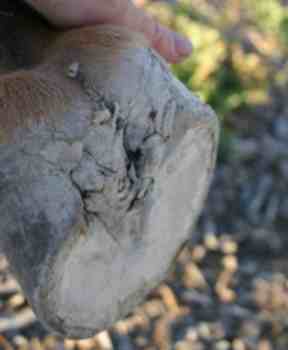 |
||
| Below: After the trim, re-soak and lunging, most of the bar is out of the buttress and the wall has been slightly beveled. | |||
|
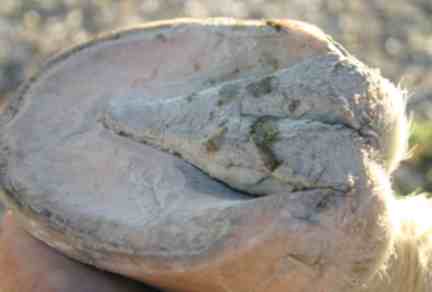 |
||
Serving the greater SF Bay Area & Northern California
Home | Contact Linda | Privacy | About Us
